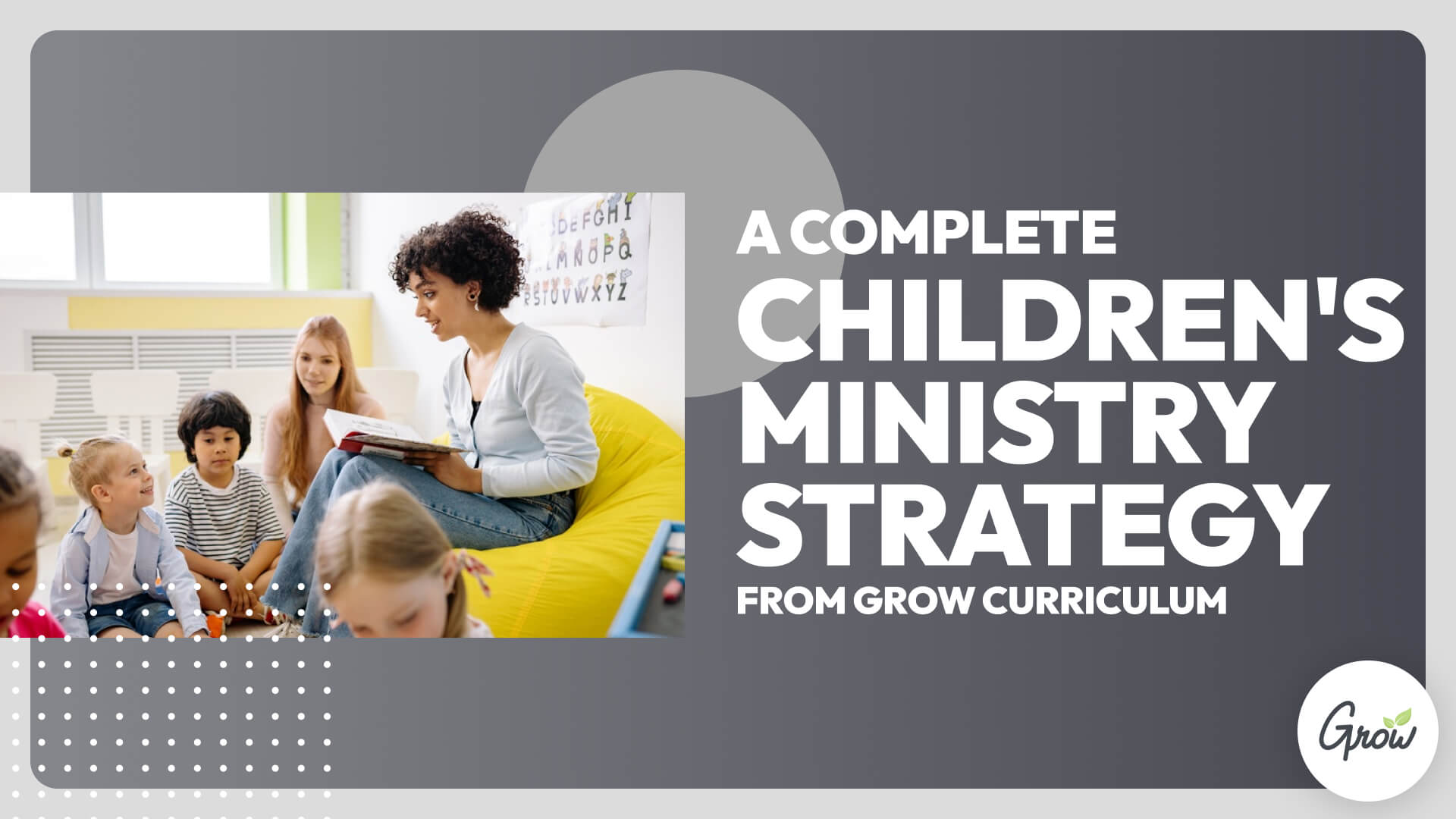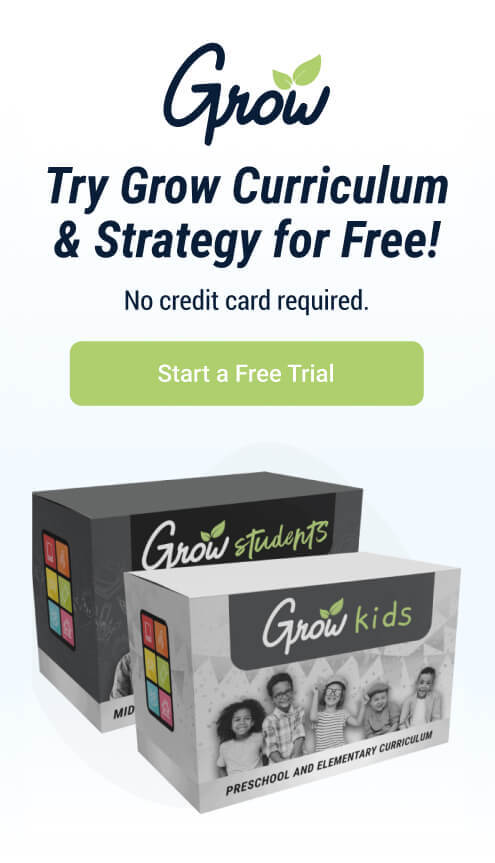Have you ever been told you need a “strategy” for your children’s ministry? You do need a strategy, but sometimes, when people talk about their ministry “strategy,” they’re not talking about strategy at all. Instead, they’re talking about…
- A goal they want to reach.
- A dream or vision they have.
- A philosophy about how things should be done.
- A set of values they believe are essential.
All of these things are important! But they’re not strategies. Your goals, dreams, visions, philosophies, and values help you decide where your kids ministry is going, but your strategy tells you how to get there.
So, what’s an example of a ministry strategy that really is a strategy? We’re so glad you asked! Because we developed one — and you can steal it! For free!
If you’re familiar with Grow Curriculum & Annual Strategy, some things in this post might sound familiar to you. That’s because everything we do in Grow Kids Curriculum is based on the strategy we’re about to break down for you! But don’t worry if you’ve never used Grow Kids in your ministry before. You can still steal our strategy! Take the ideas you find helpful, ignore the parts that don’t quite fit your context, and combine them with the unique language, vision, and strategy of your church.
Now, let’s get started!

THE GROW STRATEGY
We picked the name “Grow” for a simple reason: because we want to see you, the kids and teenagers you lead, and your ministry all grow! And we’re not just talking about numerical growth. We’re talking about growing closer to Jesus, growing deeper and healthier relationships, and building a ministry that’s growing healthier all the time (and not just growing bigger).
But remember, a strategy is more than just a goal — it’s a plan to help you reach your goal. That’s why the Grow strategy is a practical, customizable, and very doable plan to help your ministry grow in a healthy way.
To do that, the Grow Strategy is a complete annual plan in seven areas of ministry: discipleship, teaching, environments, events, volunteers, families, and even your annual planning. So, let’s look at all seven, one at a time!
1. DISCIPLESHIP
Discipleship isn’t about taking a kid through a specific class or workbook. It isn’t about learning, memorizing, or winning Bible trivia competitions. Discipleship is when kids begin to put their faith into practice. It doesn’t always look the same for every person, and it can be messy sometimes. But even though discipleship isn’t a one-size-fits-all program, that doesn’t mean we can’t put a strategy around it.
To help kids grow spiritually, the Grow strategy focuses on helping to build four specific spiritual habits:
- SPEND TIME WITH GOD: Spending time with God is about helping kids and teenagers develop personal spiritual disciplines. It can look like opening the Bible, talking with God through prayer, discovering how they best connect with God through worship, and whatever else helps them connect with God personally. When they spend time with God, their faith grows!
- SPEND TIME WITH OTHERS: This spiritual habit is about helping kids and teenagers grow in godly relationships with others. We can do this within our churches through small groups and mentoring relationships. But we can also do this by encouraging kids and teenagers to develop healthy relationships with others in their families, schools, and communities. Through godly relationships, their faith can grow!
- USE YOUR GIFTS: It’s so essential for kids and teenagers to discover how God made them and who God made them to be. As they begin to discover how God uniquely created them, we get to help them use their unique gifts to love God and serve others. When they use their gifts, their faith grows!
- SHARE YOUR STORY: Kids and teenagers need to learn how to talk about who God is and what God is doing in their lives. Sharing their stories of faith isn’t just something they should do when speaking into a microphone or sharing a testimony. Faith should become a regular, ongoing, go-to topic of conversation for kids and teenagers. When they share their stories, their faith grows!
So, what makes this a strategy? These ideas about discipleship only become a discipleship strategy when you put them on your ministry calendar in a way that’s actionable! Here’s how we do that with Grow.
2. TEACHING
There are so many different ways to approach your teaching time for kids. There are countless models, structures, and formulas you can follow to teach the Bible in compelling and practical ways. But we like to think about teaching in terms of three questions the kids in your church are asking every time a grown-up stands up to teach them something:
- WHAT? What are we talking about?
- SO WHAT? Why does it matter to God and to us?
- NOW WHAT? What should we do about what we just learned?
(If you’ve ever used Grow Kids Curriculum, those three questions might be familiar. And if not, you can always try it for free, if you want!)
Now, when some people hear the word “teaching,” they automatically picture a class or a sermon. But when you’re talking about kids, the truth is kids never learn best just by listening to a sermon. Instead, there are other, more effective, and engaging ways to help kids learn, like…
- QUESTIONS AND POLLS give kids the chance to share their opinions and thoughts.
- PERSONAL STORIES give them real-life examples of faith, doubt, and difficulties to learn from and remind them they’re not alone.
- IMAGES, VIDEOS, AND MUSIC engage their eyes and ears and help us capture their attention when it wanders.
- OBJECT LESSONS give concrete experiences to help them understand or remember abstract ideas.
- ACTIVITIES get them moving and interacting in ways that will help them remember what they’ve learned because they didn’t just hear it — they experienced it.
- MOMENTS OF REFLECTION give them a chance to sit quietly, write, think, or pray so they can process what is being taught.
- OPPORTUNITIES FOR RESPONSE give them a chance to do something about what they’ve learned, like make a commitment or choose a next step.
- DISCUSSION gives them an opportunity to have conversations with their peers and with grown-ups, about what they’re learning — and it might just be the most important teaching method of all.
But so far, we’ve only talked about how you teach. There’s also the question of your scope and sequence, which is what you’ll teach and when you’ll teach it. And that part of your strategy probably needs to be different depending on which age you’re teaching since kids, teenagers, and adults all have different needs and learn in different ways.
So, what makes this a strategy? These ideas about teaching only become a teaching strategy when you put them on your ministry calendar in a way that’s actionable! Here’s how we do that with Grow Kids and here’s how we do it with Grow Students.
3. ENVIRONMENTS
Next, let’s talk about your weekly environments — the physical, emotional, and relational environments you’re creating each week. And yeah, we know this one might feel kind of silly or unimportant when compared to discipleship and teaching Scripture. But it’s actually essential! The environments we create are so important, they can actually make or break whether or not kids receive the message we’re trying to share with them.
When you think of environments, you might immediately think about cool decorations, comfortable seating, or engaging music, but it’s so much bigger than that. It’s about creating environments that help everyone feel welcome in your church, and that reinforce what you’re teaching.
For kids, it means focusing on having fun through age-appropriate games and play, using all of our senses, and prioritizing safety so kids are free to learn and grow.
So, what makes this a strategy? These ideas about your weekly environments only become an environment strategy when you put them on your ministry calendar in a way that’s actionable! Here’s how we do that with Grow.
4. EVENTS
Whether you love big ministry events or kind of dread them, there’s no denying a well-planned and strategic ministry event can make a big impact. But if we’re not careful, we can easily fill up our ministry calendars with more events than we need, which creates some problems.
- It adds to the chaos of families who are equally busy.
- It burns out our staff and volunteer teams, who are also pretty busy.
- It gives kids and families so many options that we’d probably only see them at a handful of things each year, resulting in lower participation in everything we do.
- It uses time, money, and resources on things that aren’t always strategic.
With so many options, we need a strategy to help us guide which events we’ll do and when which is why the Grow strategy is all about doing fewer events for a bigger impact. In ministry, we can’t do everything, but everything we do can be done with a clear purpose. When you boil it down, it is not just about participation but strategy. Even the most well-attended events can hinder our growth if we’re not using them to lead somewhere strategic.
So, what makes this a strategy? These ideas about events only become an events strategy when you put them on your ministry calendar in a way that’s actionable! Here’s how we do that with Grow.
5. FAMILIES
Okay, so far, we’ve only talked about things that impact the kids in your church. But your ministry isn’t only for the kids in your care! It extends to their parents and families, too. Each person in your ministry belongs to a family and is being parented by at least one adult (and not always their biological parent).
There are two mistakes we tend to make when it comes to parents. We forget parents exist by trying to lead without ever engaging parents. And we get frustrated by parents for not doing what we want them to do. But what if we tried to reevaluate the assumptions we make about parents? What if we took a step back to consider the expectations we hold of parents?
Rather than always expecting parents to support our ministries, what if we focused on earning parents’ trust instead? It’s more challenging work, but it’s worth it! We can build that trust through…
- FAMILY EVENTS that provide value to parents and connect them with their kid, your church, or both.
- PARENT MEETINGS to create space for parents and guardians to learn more about a specific topic.
- PARENT DISCUSSION GROUPS where a small but diverse group of parents and guardians can connect to share stories and parenting tips with each other.
- PARENT CONVERSATIONS where you or other ministry leaders can connect with parents one-on-one to build a relationship, provide support, or give and receive feedback.
- PARENT COMMUNICATION to help you connect and share important information with families outside your weekly program.
- PARENT TOOLS and resources that help parents connect with both your ministry and their kids.
- PARENT CELEBRATIONS to honor and acknowledge parents for how they’re caring for the kids and teenagers they love.
So, what makes this a strategy? These ideas about investing in families only become a family strategy when you put them on your ministry calendar in a way that’s actionable! Here’s how we do that with Grow.
6. VOLUNTEERS
Volunteers are the backbone of any ministry. Whether you have one volunteer or one hundred volunteers (wouldn’t that be nice?), volunteers are essential. To help kids and your ministry grow, you’ll need to focus on the incredible people who give up their time to love and support the kids at your church. You can help remind volunteers they’re doing something that matters through…
- VOLUNTEER EVENTS that serve as a major opportunity to cast your vision for ministry.
- VOLUNTEER MEETINGS that give you the opportunity to teach volunteers about a specific topic.
- VOLUNTEER DISCUSSION GROUPS to gather the volunteers in small groups that serve in similar roles to share stories, ideas, and best practices with each other.
- VOLUNTEER CONVERSATIONS where ministry leaders can connect with volunteers one-on-one to build a relationship, provide support, or give and receive feedback.
- VOLUNTEER COMMUNICATION strategies to help you connect and share important information with volunteers outside of your weekly program.
- VOLUNTEER TOOLS and resources that help volunteers make their jobs happen.
- VOLUNTEER CELEBRATIONS to honor and acknowledge volunteers for what they’ve accomplished or who they are.
So, what makes this a strategy? These ideas about leading volunteers only become a volunteer strategy when you put them on your ministry calendar in a way that’s actionable! Here’s how we do that with Grow.
7. ANNUAL PLANNING
At first glance, #7 on this list might seem a little boring. Or it might seem like we’re just trying to add things to the list until we get to God’s favorite number. But hang in there, because this one might actually be the most important part of this whole thing!
Like we’ve been saying (we’ve said it six times, at least), these ideas we’ve talked about only become a strategy when you put them on your ministry calendar in a way that’s actionable. That’s why we’ve made you a whole walkthrough video of how to take these ideas and put them on your ministry calendar. That’s how you go from an idea to a strategy.
So, the final step is to take these ideas we’ve talked about and put them on your calendar. If you do that, instead of just winging it every month (or every week), here’s what we think will happen:
- You’ll be less stressed.
- You’ll never have to wonder what you’re doing next week.
- Your volunteers, parents, and kids will be better informed.
- Your lead pastor will say things like, “We have the best kids pastor ever!” (Maybe. Hopefully. Possibly.)
- You can take a nap once in a while.
But, most importantly, when you have an annual plan to turn your ideas and goals into a strategy, you’ll make a much bigger impact.
So whether you use Grow Kids Curriculum or not, we hope you’ll steal our strategy! We developed it over lots of years of ministry, with input from lots of church leaders and lots of trial and error. Take it, tweak it, and make it your own. We really hope it helps you be just a little more awesome at what you do this year!















In this post, here’s what we’ll cover: